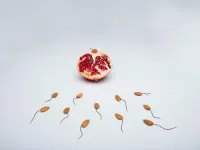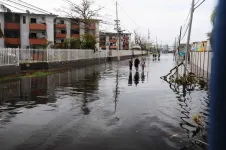Odds of stem cell transplant restoring fertility are as random as a coin toss -- until now
The odds of restoring fertility through a sperm stem cell transplant are as random as a coin toss. But a team of scientists found a way to rig the outcomes.
2021-06-07
(Press-News.org) The ability of stem cells to fix impaired functions of host tissues after transplantation has been a lifesaving breakthrough in treating previously incurable conditions. Much like a coin toss, however, the fate of the transplanted stem cells is unpredictable. They may choose self-renewal, grow into a different kind of tissue, or die.
Spermatogonial stem cells follow the same stochastic fate of unpredictability in outcomes. But a group of fertility scientists led by Hiroshima University's Yoshiaki Nakamura discovered a new method that has favorably flipped the odds and successfully reversed male infertility in mice -- showing great promise for future applications in regenerating human sperm after cancer treatment and repopulating threatened and endangered species. Results of their study are published in the journal Cell Stem Cell.
"Transplantation of spermatogonial stem cells promises a wealth of applications such as the treatment of infertility in men and the preservation of genetic diversity. Yet, currently, its inefficiency rules out the practical application of this technology," Nakamura, assistant professor at the HU Graduate School of Integrated Sciences for Life, said.
"Our knowledge about the fate behavior of individual spermatogonial stem cells and their progenies following transplantation remains poorly developed, limiting the potential to develop new strategies to increase the currently low transplantation efficiencies," he added.
Taking an up-close look at single-cell resolution, the international team of Japanese and British scientists tracked the fate of transplanted spermatogonial stem cells in mice. They implanted normal mouse sperm stem cells in infertile mice and found that only a tiny fraction repopulates in the long-term as working spermatogonia and the rest change into a different type of cell -- a process called differentiation -- or cease to carry out its function and die.
Using these insights, they developed a new method that can artificially tune the fate of the sperm stem cells to increase the likelihood of repopulation to a level where fertility is restored. They briefly introduced a retinoic acid synthesis inhibitor after transplantation, which temporarily prevented the donor sperm stem cells from undergoing differentiation. The chemical inhibitor helped orchestrate an outcome where the stem cells choose a fate of self-renewal.
"We demonstrated that repopulation efficiency of transplanted spermatogonial stem cells increased by tuning their stochastic fate," Nakamura said, adding that the next step for their research is to confirm if their new strategy will also work for livestock and eventually humans.
"My final objective is to apply spermatogonial stem cell transplantation for the fertility of male individuals with cancer after chemotherapy or the preservation of genetic diversity in farm animals and rare or endangered wild animals," he said.
INFORMATION:
About Hiroshima University
Since its foundation in 1949, Hiroshima University has striven to become one of the most prominent and comprehensive universities in Japan for the promotion and development of scholarship and education. Consisting of 12 schools for undergraduate level and 4 graduate schools, ranging from natural sciences to humanities and social sciences, the university has grown into one of the most distinguished comprehensive research universities in Japan. English website: https://www.hiroshima-u.ac.jp/en
[Attachments] See images for this press release:

ELSE PRESS RELEASES FROM THIS DATE:
2021-06-07
Normally, the ACE2 enzyme helps regulate our blood pressure. The enzyme sits on the surface of cells, including cells in the lungs, but in connection with COVID-19 it has been found that ACE2 also functions as a gateway for the virus.
"Different viruses have different ways of accessing our cells - as the virus must, of course, get into the cell to be able to replicate, and the coronavirus uses ACE2 to gain access. For this reason, we're investigating what the concentration of ACE2 means for the course of the disease, if you get COVID-19," explains MD and PhD Tue Wenzel Kragstrup from the Department of Biomedicine at Aarhus University. The preliminary results have just been published in the scientific journal PLOS ONE.
As mentioned, ACE2 is part of the surface of the cells, but ...
2021-06-07
AUSTIN, Texas -- Puerto Rico is not ready for another hurricane season, let alone the effects of climate change, according to a new study that shows the island's outstanding capacity to produce record-breaking floods and trigger a large number of landslides.
The latest research, appearing in the journal END ...
2021-06-07
Jet packs, robot maids and flying cars were all promises for the 21st century. We got mechanized, autonomous vacuum cleaners instead. Now a team of Penn State researchers are exploring the requirements for electric vertical takeoff and landing (eVTOL) vehicles and designing and testing potential battery power sources.
"I think flying cars have the potential to eliminate a lot of time and increase productivity and open the sky corridors to transportation," said Chao-Yang Wang, holder of the William E. Diefender Chair of Mechanical Engineering and director of the Electrochemical Engine Center, Penn State. "But electric vertical takeoff and landing vehicles are very challenging technology for the batteries."
The researchers define the technical requirements ...
2021-06-07
Bdelloid rotifers are multicellular animals so small you need a microscope to see them. Despite their size, they're known for being tough, capable of surviving through drying, freezing, starvation, and low oxygen. Now, researchers reporting in the journal Current Biology on June 7 have found that not only can they withstand being frozen, but they can also persist for at least 24,000 years in the Siberian permafrost and survive.
"Our report is the hardest proof as of today that multicellular animals could withstand tens of thousands of years in cryptobiosis, the state of almost completely arrested metabolism," says Stas Malavin ...
2021-06-07
The aurora borealis, or northern lights, that fill the sky in high-latitude regions have fascinated people for thousands of years. But how they're created, while theorized, had not been conclusively proven.
In a new study, a team of physicists led by University of Iowa reports definitive evidence that the most brilliant auroras are produced by powerful electromagnetic waves during geomagnetic storms. The phenomena, known as Alfven waves, accelerate electrons toward Earth, causing the particles to produce the familiar atmospheric light show.
The study, published online June 7 in the journal Nature Communications, concludes a decades-long quest to demonstrate experimentally the physical mechanisms for the acceleration of electrons by Alfven waves under ...
2021-06-07
What The Study Did: In this study, short-term effectiveness of the first dose of the BNT162b2 (BioNTech/Pfizer) vaccine against SARS-CoV-2 infection 13 to 24 days after immunization in a real-world setting was assessed.
Authors: Gabriel Chodick, Ph.D., of the Maccabi Institute for Research & Innovation, Maccabi Healthcare Services, in Tel Aviv, Israel, is the corresponding author.
To access the embargoed study: Visit our For The Media website at this link https://media.jamanetwork.com/
(doi:10.1001/jamanetworkopen.2021.15985)
Editor's Note: Please see the article for additional information, including other authors, author contributions and affiliations, ...
2021-06-07
What The Study Did: Among children with a COVID-19 diagnosis, researchers in this study examined what other conditions are common and which are associated with severe COVID-19 illness.
Authors: Lyudmyla Kompaniyets, Ph.D., of the U.S. Centers for Disease Control and Prevention in Atlanta, is the corresponding author.
To access the embargoed study: Visit our For The Media website at this link https://media.jamanetwork.com/
(doi:10.1001/jamanetworkopen.2021.11182)
Editor's Note: Please see the article for additional information, including other authors, author contributions and affiliations, conflict of interest and financial disclosures, ...
2021-06-07
What The Study Did: Researchers analyzed conversations on public Facebook groups to explore automated misinformation.
Authors: John W. Ayers, Ph.D., M.A., of the University of California, San Diego, in LaJolla, is the corresponding author.
To access the embargoed study: Visit our For The Media website at this link https://media.jamanetwork.com/
(doi:10.1001/jamainternmed.2021.2498)
Editor's Note: The article includes conflict of interest and funding/support disclosures. Please see the article for additional information, including other authors, author contributions and affiliations, conflict of interest and financial ...
2021-06-07
La Jolla, Calif. (June 07, 2021) -- "The coronavirus pandemic has sparked what the World Health Organization has called an 'infodemic' of misinformation," said Dr. John W. Ayers, a scientist who specializes in public health surveillance. "But, bots --like those used by Russian agents during the 2016 American presidential election-- have been overlooked as a source of COVID-19 misinformation."
A new study published in JAMA Internal Medicine led by Dr. Ayers, Co-Founder of the Center for Data Driven Health and Vice Chief of Innovation within the Division of Infectious Diseases ...
2021-06-07
While DNA provides the genetic recipe book for biological form and function, it is the job of the body's proteins to carry out the complex commands dictated by DNA's genetic code.
Stuart Lindsay, a researcher at the Biodesign Institute at ASU, has been at the forefront of efforts to improve rapid DNA sequencing and has more recently applied his talents to explore the much thornier problem of sequencing protein molecules, one molecule at a time.
In a new overview article, Lindsay's efforts are described along with those of international colleagues, who are applying a variety of innovative strategies for protein sequencing at the single-cell, and even single-molecule ...
LAST 30 PRESS RELEASES:
[Press-News.org] Odds of stem cell transplant restoring fertility are as random as a coin toss -- until now
The odds of restoring fertility through a sperm stem cell transplant are as random as a coin toss. But a team of scientists found a way to rig the outcomes.




